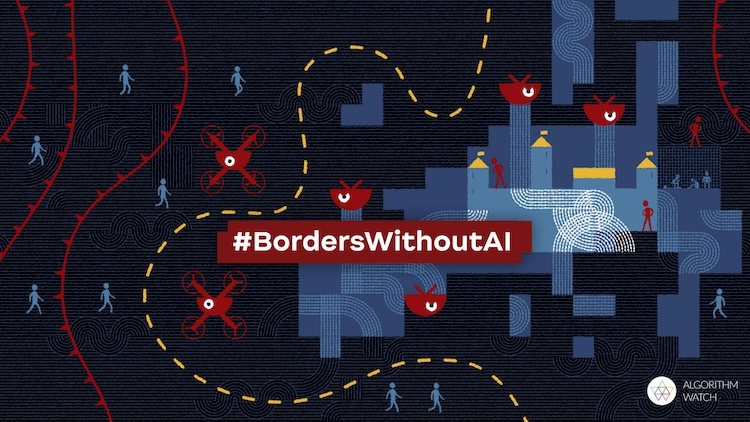By Fabio Chiusi*
The writer is a Research Associate at the AlgorithmWatch NGO
TURIN, Italy | 24 May 2024 (IDN) — 29,000 people have died in the Mediterranean over the past ten years while trying to reach the EU. You would think that the EU wanted this tragedy to stop and scientists across Europe were working feverishly on making this happen with the latest technology. The opposite is the case: With the help of so-called Artificial Intelligence, digital border walls are being raised, financed with taxpayers’ money.
Drones, satellites, and other digital monitoring systems: For decades, the EU’s external borders have been upgraded with state-of-the-art surveillance technology to create so-called smart borders. Now, algorithms and Artificial Intelligence are increasingly adding to the wall.
Their development is funded with millions of euros by EU research programs with names like Horizon 2020 or Horizon Europe. The funded projects read like a catalog of surveillance technologies. Instead of trying to save people from losing their lives, they put all of us in danger.
It doesn’t come as a surprise that most initiatives are kept secret. The public learns next to nothing about them. Law enforcement and border authorities prefer not to be bothered with giving insights into their work. They try to avoid a democratic debate about the research and development of this sort of AI-driven surveillance technology.
What the EU prefers to keep out of the public’s eye
When we asked for information on research projects in which such systems are being developed, we received many responses that wouldn’t give us any substantial information.
The European Research Executive Agency (REA) is mandated by the EU Commission to fund and manage innovative projects in virtually all areas of research, including Horizon 2020. Still, the REA isn’t particularly outspoken about their research projects.
We had tried, for example, to obtain details about the ROBORDER project‘s “methodology applied for the evaluation of the system performance” through access to information requests. At first, we were denied it in reference to the “protection of the public interest as regards public security.” The identity and affiliation of individuals involved in the ethics review process would also not be shared, to protect their “privacy and integrity.” REA also cited “commercial interests” and the protection of intellectual property as lawful grounds to refuse disclosure: “releasing this information into public domain would give the competitors of the consortium an unfair advantage, as the competitors would be able to use this sensitive commercial information in their favour.” These reasons given to us to avoid disclosure were common reactions to all the requests we sent out. But in the end, REA did provide us with information on the methodology.
More transparency is urgently needed. ROBORDER aims at developing unmanned vehicles to patrol EU borders, capable of operating in swarms. Such capabilities would most likely be of interest to the military as well. In fact, research by AlgorithmWatch and ZDF Magazin Royale shows that in a market analysis conducted within the ROBORDER project, “military units” have been identified as potential users of the system. Documents we obtained show that members of the research team met with prospective officers of the Greek Navy to introduce the ROBORDER system.
Military applications would exclude ROBORDER from Horizon 2020 funding, which is reserved for civilian applications. However, an EU Commission’s spokesperson said that the mere fact that a “military audience” was also chosen to disseminate the project does not “per se call into question the exclusively civilian application of the activities carried out within the framework of this project.”
The ROBORDER project was executed as planned until its scheduled end in 2021. Its output contributed to later projects. At a national level, one is REACTION, which is funded by the EU’s Border Management and Visa Instrument and coordinated by the Greek Ministry of Immigration and Asylum. AlgorithmWatch and ZDF Magazin Royale tried to ask the Greek research center CERTH – which coordinated ROBORDER and is now working on REACTION – what results or components exactly were adopted, but we didn’t get an answer.
Due to our persistence, we managed to obtain documents for various EU-funded projects. Some of them we received were so heavily redacted that it was impossible to get an idea what they were about. The grant agreement and the annexes to the NESTOR project contained 169 consecutive redacted pages.
Just another brick in the automated wall
An automated Fortress Europe would also impact everyone’s rights, since the technology it facilitates allows governments to find out everything about us.
How do they do it, you ask? By using face recognition, for example, and by reducing your identity to your face and other measurable biometric features. Faces can be captured and analyzed by increasingly sophisticated biometric recognition systems. In the D4FLY project, they combine “2D+thermal facial, 3D facial, iris and somatotype biometrics.” In projects such as iBorderCtrl, they examine emotions and “micro-expressions,” fleeting facial expressions that last only fractions of a second, to assess whether travelers are lying to (virtual) border officials. That way, risk assessments are automatically created, which could lead to stricter security checks at EU borders.
Such EU-funded projects are designed to digitalize, computerize, and automate human mobility. The EU envisions a future where law-abiding travelers enjoy uninterrupted freedom, while “risky” people are automatically flagged for further checks.
As Frontex’ deputy executive director, Uku Särekanno, put it in a recent interview: „What comes next is a very serious discussion on automation. We are looking into how, in the next five to ten years, we can have more automated border crossings and a more seamless travel experience.”
According to various scientists, this is the result of over two decades’ work, ultimately leading to total remote surveillance and thus to a perfect panoptic society, in which we are utterly dominated by such digital technologies and the underlying logic of security policy.
Skimming through the surveillance catalogue
Checking people requires time and resources. Therefore, some projects aim to automatically “relieve” border officials, which means make them auxiliaries for automated systems that are falsely assumed to be more objective or reliable.
Automated systems are supposed to detect “abnormal behavior,” increase “situation awareness,” and derive real-time information and predictions (“nowcasts“) from multiple sensors attached to individuals, groups, but also freighters or other vehicles. Migration movements are to be predicted algorithmically, by analyzing Google Trends data, content on social media platforms such as Facebook and X (formerly Twitter), and “quantitative (geo-located) indicators of telephone conversations.” But such automated systems can’t replace political decisions by taking available data and leaving the decision to algorithms. The decisions have to be justified. Political decisions are also not only a byproduct of technological solutions and have to be put first.
Risks become apparent by looking at the ITFLOWS project’s EuMigraTool. It includes “monthly predictions of asylum applications in the EU” and is supposed to “identify the potential risks of tensions between migrants and EU citizens” by providing “intuitions” on the “attitudes towards migration” in the EU using “Twitter Sentiment Analysis model data as input”. The very project’s Users Board, in which organizations such as the Red Cross and Oxfam are represented, warned in a statement against misuse, “misuse could entail closing of borders, instigating violence, and misuse for political purposes to gain support and consensus for an anti-migration policy.” The tool was developed nonetheless.
In these EU-funded projects, people on the move are constantly portrayed as a threat to security. The FOLDOUT project explicates this core premise in all frankness: “in the last years irregular migration has dramatically increased,” therefore it was “no longer manageable with existing systems.” Law enforcement and border agencies now assume that in order to “stay one step ahead” of criminals and terrorists, automation needs to become the norm, especially in migration-related contexts.
FRONTEX is everywhere
A driving force in border security is also one of the main customers: Frontex. Founded in 2004, the European Border and Coast Guard Agency has played an increasingly important role in the EU’s research and innovation projects in recent years. The agency’s budget has increased by 194 percent compared to the previous budget, and by an incredible 13,200 percent in the last 20 years. But Frontex’ influence goes far beyond the money at its disposal. The agency intervened to “help,” “actively participate in,” and “push forward” several Horizon 2020 projects, addressing “a wide spectrum of technological capabilities critical for border security,” including Artificial Intelligence, augmented reality, or virtual reality.
In 2020, the agency formalized their collaboration with the EU Commission’s Directorate-General for Migration and Home Affairs (DG-HOME). It allowed Frontex to provide assistance to DG-HOME “in the areas of programming, monitoring and the uptake of projects results.” The agency is now responsible for “identifying research activities,” evaluating research proposals, and the supervision of the Horizon Europe research projects’ “operational relevance.”
The agency therefore joined EU-funded projects trials, demonstrations, and workshops, held events involving EU-funded projects, and even created a laboratory (the Border Management Innovation Centre, BoMIC) to help implement EU-funded projects in border security. This is complemented with Frontex’s own “Research Grants Programme”, whose first call for proposals was announced in November 2022, to “bring promising ideas from the lab to real applications in border security.”
How is this supposed to become a reality?
The NESTOR project promises “an entirely functional, next-generation, comprehensive border surveillance system offering pre-frontier situational awareness beyond sea and land borders.” The system is based on optical, thermal imaging, and radio frequency spectrum analysis technologies. Such data will be “fed by an interoperable sensors network” comprised of both stationary installations and mobile manned or unmanned vehicles (that can operate underwater, on water surfaces, on the ground, or in the air). The vehicles are also capable of functioning in swarms. This allows for detecting, recognizing, classifying, and tracking “moving targets” such as persons, vessels, vehicles, or drones. A “Border Command, Control, and Coordination intelligence system” would adopt “cutting-edge Artificial Intelligence and Risk Assessment technologies”, fusing “in real-time the surveillance data in combination with analysis of web and social media data.”
The key term here is “pre-frontier awareness.” According to the EU, “pre-frontier” refers to “the geographical area beyond the external borders which is relevant for managing the external borders through risk analysis and situational awareness.” Or, to put it bluntly: the very notion of “border” ultimately dissolves into whatever the authorities want it to mean.
The list of projects could go on and on but you get the EU’s gist: They perceive migrants as a threat and want to better protect their borders from them by constantly improving automation and ever-increasing surveillance − far beyond existing borders. The EU conjures up the image of a migration “crisis” that we can only hope to end through technological solutions.
A wishful-thinking approach to AI-based surveillance and control
This belief is extensively and increasingly affirmed and shaped by the border and coast guard community in lockstep with the surveillance and security industries, as has been well documented. But it threatens social justice, non-discrimination, fairness, and a basic respect of fundamental rights. “Ethics assessments” only scratch at the surface of the complexity of automating migration. The systems will be developed anyway, even if the assessments fundamentally question whether the systems’ use can be justified at all. Many of these projects should not have been funded in the first place, so they should not be pursued. [IDN-InDepthNews]

*Fabio Chiusi is our project lead for Automation on the Move. Before that, he was project lead for Tracing the Tracers in 2021 and also for the Automating Society Report 2020. He was a Fellow at the Nexa Center for Internet & Society in Turin and an Adjunct Professor at the University of San Marino, where he teaches journalism, publishing, and new media. After a decade in tech reporting, he worked as a consultant and assistant researcher in data and politics for the NGO Tactical Tech . For Polis LSE, the London School of Economics’ media think-tank, he researched AI in journalism.
Original link: https://algorithmwatch.org/en/borders-without-ai/
Image credit: AlgorithmWatch


